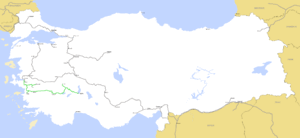- Oriental Railway Company
-
Oriental Railway Company
Anatolian railways in 1910 (ORC in green).Reporting mark ORC Locale Southwestern Anatolia Dates of operation 1856–1935 Track gauge 4 ft 8 1⁄2 in (1,435 mm) (standard gauge) Headquarters İzmir, Turkey The Oriental Railway Company (ORC) or the İzmir-Aydın Railway (Turkish: İzmir-Aydın Demiryolu) was the first railway in Anatolia. The railway operated from 1856 to 1935 when TCDD absorbed it.
History
The ORC concession was given on September 22, 1856 to build and operate the line between İzmir and Aydın. The concession was to last for 50 years from October 1, 1860, the date originally agreed for the opening of the line. However, construction time and cost were underestimated, the estimated initial capital of £1.2 million proved too small and the opening to Aydın had to be delayed until 1866.
The first section, from İzmir to Seydiköy, was opened on October 30, 1858 and was the first railway in Anatolia and in the Ottoman Empire, the second in the Middle East after the Alexandria to Cairo line in Egypt (opened in 1856).
The ORC obtained additional concessions step by step and managed to extend the line as far as Eğridir in 1912. The ORC also acquired in 1921 the suburban line from Şirinyer to Buca on the outskirts of İzmir, which operated since 1870. The intent of the company was to carry mineral and agricultural goods from the rich Menderes Valleys to the port of İzmir. However, this traffic was not enough to generate big revenues and the ORC was never highly profitable. One way out would have been to extend the network to the Anatolian Plateau, but the ORC failed to secure the concession to extend to Konya or to Afyon. Indeed railways concession were highly political, the British voters were not keen for their government to help the Ottomans building railways that might compete with other British interest in India and in the Middle East. On the other hand the CFOA which had secured railway concession in Afyon and Konya lobbied the Ottomans against further extension of the ORC. Consequently, the ORC acted very much like a colonial railway: connecting a large port to the interland, facilitating export of raw material and agricultural products and imports of manufactured products. Because of poor Ottoman planning, the ORC could play no role at integrating various large city such as Izmir with Konya.
External links
Turkish Era (1923-Present) Industrial Categories:- Railway companies of Turkey
- Ottoman railways
Wikimedia Foundation. 2010.

